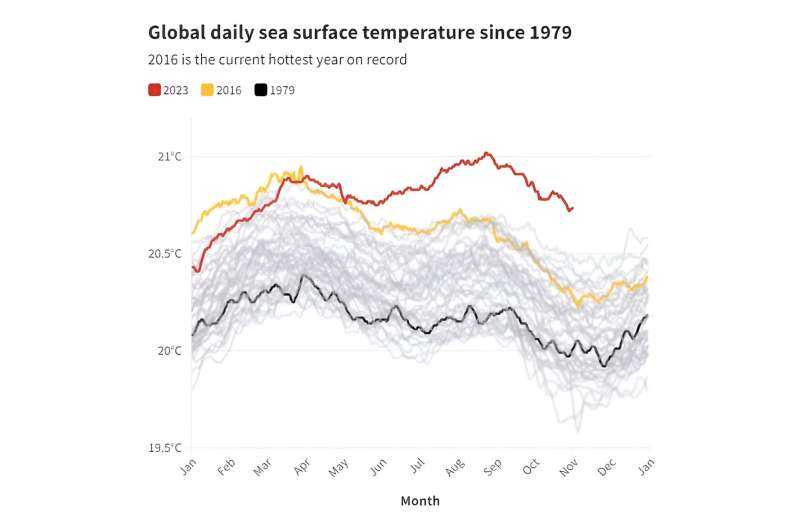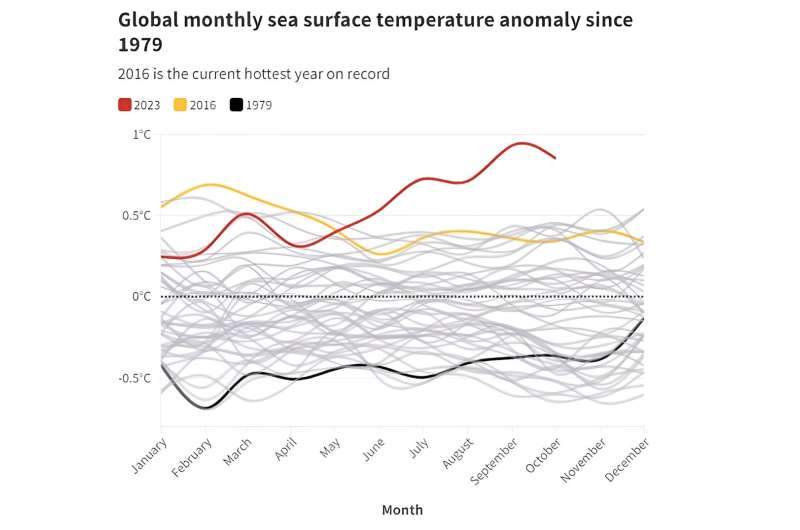This article has been reviewed according to Science X's editorial process and policies. Editors have highlighted the following attributes while ensuring the content's credibility:
fact-checked
trusted source
written by researcher(s)
proofread
In September we went past 1.5 degrees. In November, we tipped over 2 degrees for the first time. What's going on?

In September, the world passed 1.5°C of warming. Two months later, we hit 2°C of warming. It's fair to wonder what is going on.
What we're seeing is not runaway climate change. These are daily spikes, not the long-term pattern we would need to say the world is now 2 degrees hotter than it was in the pre-industrial period.
These first breaches of temperature limits are the loudest alarms yet. They come as the United Nations Environment Program warns the world is still on a path to a "hellish" 3°C of warming by the end of the century.
But they do not signal our failure. The sudden spike in warming in 2023 comes from a combination of factors—climate change, a strong El Niño, sea ice failing to reform after winter, reduced aerosol pollution, and increased solar activity. There are also minor factors, such as the aftermath of the volcanic eruption near Tonga.
How significant are these factors?
1. Climate change
This is by far the biggest factor. What many of us don't recognize is how recent our intense period of emissions is. If you were born in 1983, fully 50% of all of humanity's emissions have gone into the atmosphere since your birth. Human emissions and other activities have so far contributed about 1.2°C of warming.
Greenhouse gases trap heat, which is why the Earth is not a snowball. But the 2 trillion tons of fossil carbon we've taken from underground and put back in the atmosphere are trapping more heat. And more heat. And will continue to do so until we stop burning fossil fuels for heat or power.
2. El Niño
The El Niño-Southern Oscillation climate cycle in the Pacific has the biggest natural influence on climate. That's because the Pacific is huge, accounting for 30% of Earth's surface. When in the El Niño phase, the seas off South America heat up. This, in turn, usually makes average global temperatures hotter.
Right now, there's a dangerous heat wave in Brazil, where heat and humidity combined makes it feel like 60°C. The intense heat contributed to the death of a fan at Taylor Swift's Rio concert last week.
El Niño will likely peak in the next two months. But its effects may well persist throughout 2024, driving global average temperatures higher by perhaps 0.15°C.
3. Antarctic sea ice isn't bouncing back
The declines in Arctic sea ice are well known. But now Antarctic sea ice, too, is failing to recover. Normally, the ring of frozen seawater around the ice continent reaches its maximum extent in September. But this year's maximum is well below any previous year.
As we enter summer, that means more dark water will be exposed. And since dark surfaces absorb more heat while white ones reflect it, it means still more heat will go into the oceans rather than back out to space.

4. Increased solar activity
Our sun runs on a roughly 11-year cycle, going between lower and higher output. The solar maximum was forecast for 2025, and a clear increase is occurring this year. This brings spectacular auroras—even in the Southern Hemisphere, where residents have seen auroras as far inland as Ballarat, in Victoria.
Solar maximums add extra heat. But not much—the effect is only around 0.05°C, about a third of an El Niño.
5. The volcanic hangover
Normally, volcanic eruptions cool the planet, as their vast plumes of aerosols block sunlight. But the largest volcanic eruption this century near Tonga in January 2022 did the opposite.
That's because the Hunga Tonga-Hunga Ha'apai volcano was under the sea. Its explosive force evaporated vast volumes of seawater—and water vapor is a greenhouse gas. While some skeptics like to point to this eruption as the root cause of our recent spike in warming, the Tonga eruption is a blip—it will add an estimated 0.035°C for about five years.
6. Cutting aerosol pollution
In 2020, new international shipping rules came into force, mandating low-sulfur fuels. This cut sulfur dioxide emissions by about 10%. That's good for health. But aerosols in the atmosphere can actually block heat. Cutting pollution may have added to warming. But again, the effect seems small, adding an estimated 0.05°C of warming by 2050.
What should we take from this?
The climate is enormously complex. We should see the first day 2°C warmer than the same day in the pre-industrial period as a stark warning—but not as a sign to give up.
In short, this isn't a step change. It's a combination of factors that has driven this surge. Some of those, like El Niño, are cyclical and will switch back.
But as negotiators prepare for next week's COP28 climate talks, it's yet another sign that we cannot relent.
We are—at last—seeing signs of real progress in the clean energy and clean transport rollout. This year, we may even see emissions from power generation finally peak and then begin to fall.
So—we haven't failed yet. But we are on a rapidly warming planet—and we can now clearly see the effect, even in these new daily temperature records.
Provided by The Conversation
This article is republished from The Conversation under a Creative Commons license. Read the original article.![]()




















